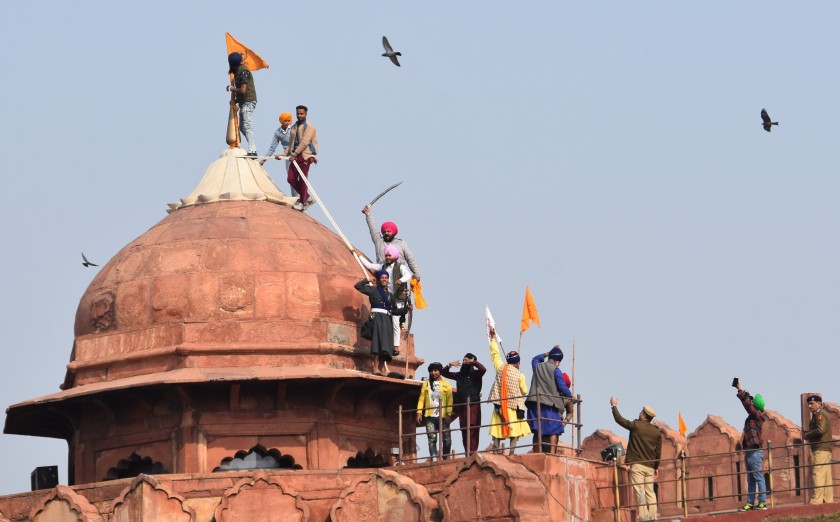NEW DELHI, (Reuters) – Thousands of Indian farmers protesting against agricultural reforms breached barricades today to enter the historic Red Fort complex in the capital and hoist flags after clashing with police, who fired tear gas to scatter them.
Growers, angered by laws they say help large, private buyers at the expense of producers, have camped outside New Delhi for almost two months, posing one of the biggest challenges to Prime Minister Narendra Modi since he came to power in 2014.
The body of one protester draped in an Indian tricolour lay in a central Delhi street after the tractor he rode overturned in one of the clashes, said a witness, Vishu Arora.
“He died right there,” Arora added.
A Reuters witness saw at least five police and three protesters injured at the Red Fort, from whose ramparts Modi delivers an annual speech. Some of those who scaled its walls carried ceremonial swords, overwhelming police who were trying to prevent them from entering.
The government ordered internet services in some parts of the capital to be blocked, according to mobile carrier Vodafone Idea, in an attempt to prevent further unrest.
Tens of thousands of bearded and turbanned farmers, many bundled against the winter cold, began the day in a convoy of tractors festooned with Indian and union flags along the city’s fringes.
But hundreds of protesters soon broke away from pre-approved routes, heading for the city centre where the government was holding an annual Republic Day parade of troops and military hardware on Tuesday morning.
“Modi will hear us now, he will have to hear us now,” said Sukhdev Singh, 55, a farmer from the northern state of Punjab, who was among hundreds of protesters, some on horseback, who broke away from one of the three protest routes.
From the city’s north they headed towards the government buildings in the centre. They commandeered cranes and used ropes to tear down roadblocks, forcing constables in riot gear to give way, Reuters witnesses said.
A second group rode tractors to get to a key central traffic junction, also breaching barricades after similar clashes with police.
“I appeal to the people to please follow the route that has been decided… and not spoil the peace and harmony of the country,” Shalini Singh, one of Delhi police’s top officers, told Indian TV channel NDTV on the clashes.
Protest organiser Samyukt Kisan Morcha said the groups swerving from set routes did not represent the majority of farmers, however.
“None of the leaders disappeared,” the grouping of farm unions said in a statement. “They are following the set routes.”
Amarinder Singh, chief minister of Punjab state where many of the protesters came from, called the clashes “shocking”.
“The violence by some elements is unacceptable,” he said in a tweet. “It’ll negate goodwill generated by peacefully protesting farmers.”
Agriculture employs about half of India’s population of 1.3 billion, and unrest among an estimated 150 million landowning farmers worries the government.
Nine rounds of talks with farmers’ unions have failed to end the protests, as farm leaders rejected the government’s offer to delay the laws for 18 months, making a push for repeal instead.
“The farm organisations have a very strong hold,” said Ambar Kumar Ghosh, an analyst at New Delhi think tank the Observer Research Foundation.
“They have the resources to mobilise support, and to continue the protest for a long time. They have also been very successful in keeping the protest really focused.”
India showcases its military hardware with a parade every year on Republic Day, which marks the adoption of its constitution in 1950.

